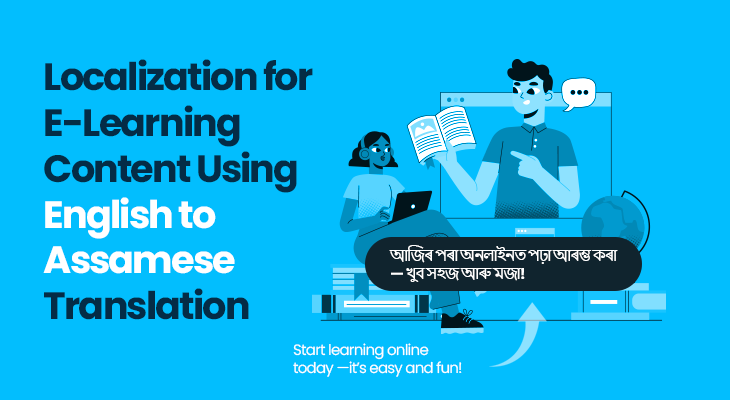If there’s one thing business owners learn quickly, it is that customer support can make or break your brand. People might like your product, but if they feel ignored or misunderstood when they reach out for help, they won’t stick around for long. And here’s something that many companies overlook. Customers want to be helped in their language.
In Assam, that language is Assamese. Now, many people can read or speak some English, but when it comes to solving a problem or explaining something important, they naturally prefer Assamese. It feels easier. More personal. Like you’re talking to someone who truly understands.
The challenge? You can’t always afford to hire a whole team of bilingual agents, and asking customers to adapt isn’t exactly good service. That’s where AI-powered English-to-Assamese translation comes in. It lets you respond instantly, in the language your customers are most comfortable with, without slowing down your operations or breaking the budget.
Why local language support matters more than ever?
India’s internet audience is vast and continues to grow. But here’s the twist: most of those new users are not English-first. Studies say around 90% of new internet users prefer content in their native language. That’s a huge deal if you’re trying to win trust and keep people happy.
When customers don’t get support in a language they know well, a few things happen:
- They get frustrated and give up mid-conversation.
- They take their business to a competitor who speaks their language.
- Minor issues can escalate into big complaints due to misunderstandings.
For Assamese-speaking customers, the difference between staying loyal and walking away can be as simple as whether or not your support team can speak their language. And no, this isn’t just about being polite. It is about doing innovative business.
The Assamese market: more than just a “regional” audience
Let’s talk about why Assamese support is worth your time. The Assamese-speaking population is over 15 million people. That’s not a small niche. With smartphone use and internet access skyrocketing in Assam, an increasing number of customers are turning to online shopping, booking travel, paying bills, and contacting businesses digitally.
The economy here is also doing well. Assam’s GDP has been growing steadily, thanks to sectors like tourism, agriculture, and IT. People are spending more, and they’re spending online. Now imagine if you’re the business that answers them in the language they use at home. Your chances of earning their trust shoot up instantly.
And there is evidence to back it up. A Common Sense Advisory survey found 72% of customers are more likely to buy a product when it is presented in their native language. That’s not just preference, that’s buying behaviour.
From slow and costly to fast and scalable: how AI changes the game
Until a few years ago, if you wanted Assamese customer support, you had two options:
- Hire native speakers.
- Use human translators.
Both work, but they’re expensive, slow, and hard to scale. If your customer volume jumps, you’re stuck scrambling for extra staff.
AI-powered translation changes all that. Using advanced machine translation APIs, it can turn English messages into Assamese (and vice versa) almost instantly. The technology isn’t just swapping words. It uses neural machine translation to understand context, tone, and meaning so your replies sound natural, not robotic.
Benefits?
- Speed – No more waiting for a translator. Answers are ready in seconds.
- Scalability – Handle hundreds or thousands of requests a day without adding headcount.
- Consistency – Keep your brand tone and style the same across every reply.
It is not about replacing people entirely. It is about providing your team with a tool that enables them to assist more customers, faster, and without errors creeping in.
What’s in it for the business?
Let’s be practical, this isn’t just about happy customers. It is also about the bottom line.
Companies that have switched to AI-powered English-to-Assamese translation for customer support have seen the following:
- Costs for translation might be up to 60% lower than hiring full-time translators.
- 30–40% faster ticket resolution times, resulting in less backlog and reduced frustration for both parties.
- 25% boosts in customer satisfaction scores simply by replying in the customer’s language.
There’s also the less obvious stuff:
- You reach more people without considerable hiring costs.
- You stand out in markets where competitors still rely on English or Hindi only.
- You’re ready for busy seasons without rushing to add temporary staff.
In other words, it is an investment that keeps paying back, in both money saved and customers gained.
How to make it work for your business?
You can’t just use a translation tool and be done with it. A few simple things that the best firms do are:
1. Connect it to the platforms you already use. Link the translation API to your helpdesk, chat platform, or CRM so that it functions where your team already does.
2. First, use a website translation company to make a list of words that are unique to your brand. In this approach, the AI may learn how you speak and what your product names mean.
3. Check the quality often—feedback helps even the greatest AI become better. Check a few translations periodically to ensure they still sound natural and correct.
4. Teach your staff how to read, approve, and, if necessary, change AI translations before sending them out. This is a tiny move that can have a major impact.
Examples from the real world
- Online shopping— A live chat on an online marketplace that added Assamese translation found an 18% decline in clients in Assam who left their carts empty.
- Banking: A regional bank deployed machine translation in its app chat feature, which decreased response times by 35%.
- Hospitality: A group of hotels started offering an Assamese chatbot service, and the number of booking requests from Assamese-speaking travelers went up by 22%.
These aren’t little wins; these are the kinds of accomplishments that change how much money you make.
Language is more than simply words; it’s how people build trust. Not only will AI-powered English to Assamese translation speed up your customer service, but it will also show consumers that you care about their comfort. And customers remember when they feel understood. They come back. They talk to other people. No matter if you’re a small business just getting started in Assam or a larger brand expanding across India, one of the smartest things you can do is speak the language of your customers. With the right tools, it’s also one of the easiest things to perform.
In conclusion
It’s not just about using AI to translate English into Assamese. It can help cut costs, speed up processes, and make customer service easier. But what was the real win? People who speak Assamese can now get help in the language they know best.
Devnagri knows how to make this work, from the technical side to making sure that every response sounds like your brand. In customer service, you don’t just fix problems. It’s about helping others see how valuable they are. And that starts with understanding what they say.



